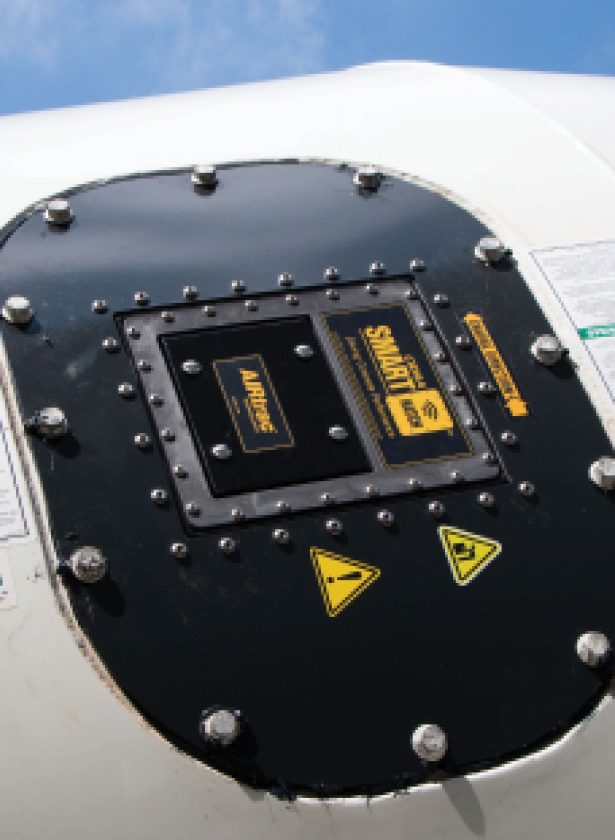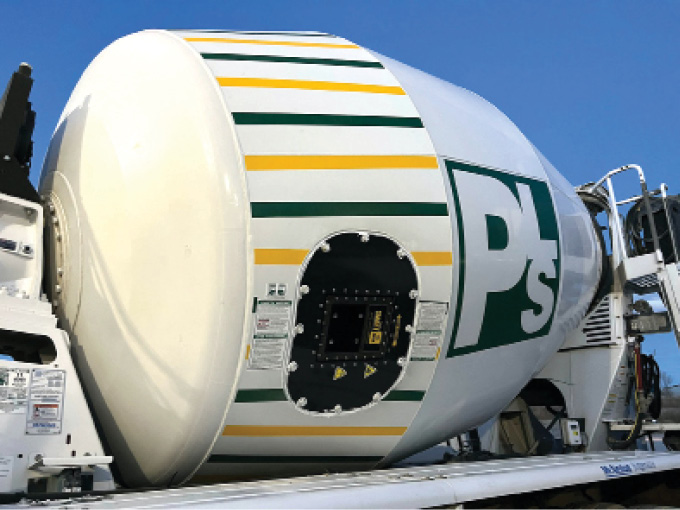A ready mixed concrete truck is more than a “truck.” It’s a mobile manufacturing environment.

PHOTOS: CiDRA Concrete Systems 
The SMARThatch system is installed on the truck mixing drum to provide continuous, real-time air and temperature measurement from batch plant to jobsite.
William Shakespeare might be tempted to say a truck by any other name is still a truck, but in the ready mixed concrete industry, a mixer truck is really a mobile manufacturing environment, or MME. Let’s take a few moments to “smell the roses.”
One of several early RMC truck innovators in the 1990s, Gary Palmer in Salt Lake City created truck tracking systems based on the old Nextel flip phone (TrackIt). Other innovators of the day included TracerNet Corp. and Grid Data.
Another early innovator was Joe Sostaric, current VP of The Conco Companies and Reliable Trucking in Northern California. As VP and general manager of the RMC California concrete operations in the 1990s, he promoted building out the truck with sensors and computers to extend the manufacturing process beyond the plant and to the end of the chute. A relentless visionary, his primary goal was for a system to use hydraulic pressure feedback from rotating the drum to indicate slump; the resulting company now is owned by GCP Technologies (VERIFI).
The list of concrete truck enhancements goes on and includes non-production technology like safety cameras. Fast forward to today’s innovators and numerous advancements are driving the evolution of MME. We can look at the forces at work and make some reasonable guesses where things will end up.
IT’S ABOUT THE ECONOMY, STUPID
In our industry, technology adoption starts with EBITDA. How confident are we that a proposed change will increase earnings? Innovators have a hard time with that question because it cannot be answered until wider adoption is achieved—but wider adoption requires, well, adoption.
Historically, MME technology has been in two camps: communication and sensors. While Palmer’s initial tracking system transmitted the most recent position as reported by the GPS sensor, it still was considered a “communication” system. Today’s significant advances in sensors empower us to do more than communicate locations (i.e., self-driving cars).
Consider the amazing things CiDRA Concrete Systems is doing. In geographies subject to freeze-thaw, entrained air content is critical for long-term durability of ready mixed concrete. Controlling entrained air content is both difficult and fraught with liability. Even if you get the air right at the plant, it may be out of tolerance by the time it reaches the jobsite.
“The mixing process generates large air voids. The kinetic energy causes the voids to break apart, then the chemistry of the constituents leads to well-dispersed entrained air,” explains Dave Newton, director of engineering and technology at CiDRA. “Our SMARThatch system allows you to see that happening in real time as the truck goes from the plant to the job.”
CiDRA’s sensor mounts inside the drum hatch to measure entrained air content. Of course, they also developed a communications platform to report the information back to dispatch and other systems.
The first advantage of using the system is knowing entrained air content at any time. Users also can catch instabilities when certain cementitious materials are used or substituted. EBITDA is increased by reducing rejected loads or worse, rip and replace.
The long-term advantage is understanding the real-time entrained air content curve. If 7 percent entrained air content is confirmed at the plant, there is no guarantee it will hold to the jobsite. Over a delivery cycle, considering time (age), revolutions and other factors, a reasonably accurate entrained air content curve can be generated for mix families and individual substitution of materials. Constant, real-time data leads directly to much more efficient admixture usage at the plant and risk mitigation.
CiDRA also provides load quantity, rotation, temp, water add and is working on slump measurement. Load quantity is critical to know when adding water and admixtures while on the jobsite, especially when partially through a discharge. It is also essential for returned yardage if overbathing is permitted.
Two other new entrants on the communications side are Digital Fleet and Coretex (now EROAD). Both have withstood the trials of the innovators’ EBITDA trap and offer proven platforms. They are racing ahead with generalized sensors to further build out the MME.

WHERE TRUCKS ARE HEADED
An annoying problem is every technology provider wants to add their display device or tablet in the truck cab. It’s an impossible situation. As an end user, you want your choice of communication platform, safety cameras, water meters, slump meters and sensor systems.
In a perfect world, you could choose what you want and be assured all the puzzle pieces will fit together. Think about your laptop and plugging in a new device; the drivers and other details are automatically configured, and you can just be a happy user.
While Shakespeare quips that “there was never yet philosopher that could endure the toothache patiently,” take hope that the long-term MME solution will evolve toward an open communications platform. Sensor systems will be developed to plug and play with various communications platforms to work as one. We just need to encourage some old-fashioned adoption.

Craig Yeack has held leadership positions with both construction materials producers and software providers. He is co-founder of BCMI Corp. (the Bulk Construction Materials Initiative), which is dedicated to reinventing the construction materials business with modern mobile and cloud-based tools. His Tech Talk column—named best column by the Construction Media Alliance in 2018—focuses on concise, actionable ideas to improve financial performance for ready-mix producers. He can be reached at [email protected].